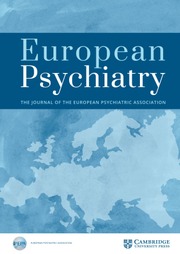No CrossRef data available.
Article contents
Features of affective disorders of the depressive spectrum after COVID-19 in patients with a history of mental disturbances
Published online by Cambridge University Press: 26 August 2025
Abstract
The structure of clinical manifestations in patients with a history of mental disturbances who suffered from COVID-19 and were exposed to the stressors of the SARS-CoV-2 pandemic is characterized by the predominance of affective disorders of the anxiety-depressive spectrum.
To investigate the structure of affective disorders of the depressive spectrum after COVID-19 in patients with a history of mental disturbances by nosological groups.
95 patients with a history of mental disorders who have experienced COVID-19 were examined and made up the main group (F 32.0-32.2, 33.1, 33.2 – 31 patients, F 06.3, 06.4 – 33 patients, F 41.1, 41.2, 42.2, 45.3, 48.0 – 31 patients). During the study, a thorough analysis of the anamnesis of the disease was carried out, including information about the experienced coronavirus disease COVID-19. Clinical-psychopathological, clinical-amnestic, psychometric (the Montgomery-Asberg Depression Rating Scale (MADRS)) and methods of statistical analysis were applied.
According to the results of the psychodiagnostic study, the features of affective disorders of the depressive spectrum of various degrees of severity were established, which had certain differences according to nosological groups. Patients with depressive disorders have depressive disturbances in the form of sleep impairment (4.48 points, p = 0.0001), manifestations of sadness (4.27 points, p ≤ 0.021), internal tension (3.95 points, p = 0.01), difficulties in experiencing feelings (3.87 points, p ≤ 0.019), concentration difficulties (3.85 points, p = 0.031), appetite disturbances (3.11 points, p ≤ 0.012), manifestations of fatigue (3.06 points, p = 0.027), pessimistic (2.78 points, p ≤ 0.026) and suicidal thoughts (1.67 points, p = 0.038). Patients with mental disorders of organic genesis are characterized by depressive disturbances in the form of a feeling of fatigue (4.18 points, p ≤ 0.021), significant concentration difficulties (4.16 points, p = 0.024), sleep deterioration (3.87 points, p = 0.018), feeling and expressing sadness (3.16 points and 3.49 points, respectively), difficulties in experiencing feelings (2.43 points, p = 0.035). Patients with neurotic, stress-related and somatoform disorders are characterized by depressive manifestations in the form of expression of sadness (4.78 points, p = 0.034), feeling of internal tension (3.67 points, p = 0.027), concentration difficulties ((2 .68 ± 0.29) points).
The results of the study of the structure of affective disorders of the depressive spectrum after COVID-19 in patients with a history of mental disturbances should be used as targets for effective therapeutic influence.
None Declared
Information
- Type
- Abstract
- Information
- European Psychiatry , Volume 68 , Special Issue S1: Abstracts of the 33rd European Congress of Psychiatry , April 2025 , pp. S625
- Creative Commons
- This is an Open Access article, distributed under the terms of the Creative Commons Attribution licence (https://creativecommons.org/licenses/by/4.0/), which permits unrestricted re-use, distribution, and reproduction in any medium, provided the original work is properly cited.
- Copyright
- © The Author(s), 2025. Published by Cambridge University Press on behalf of European Psychiatric Association


Comments
No Comments have been published for this article.